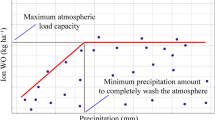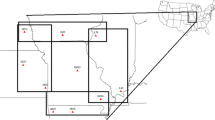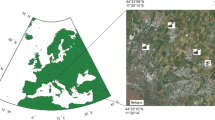Abstract
Despite the importance of long-term atmospheric deposition of ions for vegetation productivity and biogeochemistry, southern South America lacks long-term deposition records. We report a 6-year-long record of atmospheric deposition measurements of Mg2+, Ca2+, Na+, K+, Cl−, SO42−, NO3− and NH4+ in the plains of southern South America, which encompass one of the most important agricultural basins and urban clusters of the continent. After establishing a deposition measurement network across four sites in Argentina and Uruguay, we collected bulk atmospheric deposition monthly form January 2007 through December 2012 in an east–west transect of 700 km. Spatial changes in the sea-salt component of atmospheric deposition were primarily associated with proximity to the sea—as observed in other regions of the world—whereas non-sea-salt components of atmospheric deposition of terrestrial origin were primarily associated with the size of the human population surrounding collection sites. Atmospheric deposition showed a strong interannual variability (CV 50%) mainly associated with variations in the non-sea salt components of terrestrial origin and were within observed values for other relatively unpolluted sites of South America and globally. However, atmospheric deposition appears to be increasing in the region, particularly for SO42− and other ions around Buenos Aires, Argentina, which may represent an early warning of increased air pollution in the area. Average annual regional deposition of sulfate (SO42−) was 12.7 kg S hectare−1 and nitrate (NO3−) was 9.2 kg N hectare−1. Weighted average concentrations of base cations (sum of Mg2+, Ca2+, Na+ and K+) was 0.27 mg L−1, and weighted average concentrations of SO42−, NO3− and NH4+ were 0.094, 0.018 and 0.046 mg L−1, respectively. Our work highlights the need for long-term networks recording atmospheric deposition in the region, increasing knowledge of nutrient cycling and establishing a baseline for future atmospheric pollution measurements.





Similar content being viewed by others
References
Ayers GP, Fukuzaki N, Gillett RW et al (1998) Thymol as a biocide in Japanese rainwater. J Atmos Chem 30:301–310. https://doi.org/10.1023/A:1006068415125
Baker AR, Weston K, Kelly SD et al (2007) Dry and wet deposition of nutrients from the tropical Atlantic atmosphere: links to primary productivity and nitrogen fixation. Deep Sea Res Part I 54:1704–1720. https://doi.org/10.1016/j.dsr.2007.07.001
Baklanov A, Molina LT, Gauss M (2016) Megacities, air quality and climate. Atmos Environ 126:235–249. https://doi.org/10.1016/j.atmosenv.2015.11.059
Connors DN, Kester DR (1974) Effect of major ion variations in the marine eviroment on specific gravity—conductivity—chlorinity salinity relationship. Mar Chem 2:301–314
Conradie EH, Van Zyl PG, Pienaar JJ et al (2016) The chemical composition and fluxes of atmospheric wet deposition at four sites in South Africa. Atmos Environ 146:113–131. https://doi.org/10.1016/j.atmosenv.2016.07.033
De Souza PA, De Mello WZ, Maldonado J (2006) Composicao quimica da chuva e aporte atmosférico na Ilha Grande, RJ. Quim Nova 29:471–476
Erich R (1980) La depresión del Noroeste argentino
Fayiga AO, Ipinmoroti MO, Chirenje T (2017) Environmental pollution in Africa. Springer, Netherlands
Fowler D, Pilegaard K, Sutton MA et al (2009) Atmospheric composition change: ecosystems-atmosphere interactions. Atmos Environ 43:5193–5267. https://doi.org/10.1016/j.atmosenv.2009.07.068
Galloway JN, Keene WC, Likens GE (1996) Processes controlling the composition of precipitation at a remote southern hemispheric location: Torres del Paine National Park, Chile. J Geophys Res Atmos 101:6883–6897. https://doi.org/10.1029/95JD03229
Geilfus CM (2019) Chloride in soil: From nutrient to soil pollutant. Environ Exp Bot 157:299–309. https://doi.org/10.1016/j.envexpbot.2018.10.035
Hedin LO, Armesto JJ, Johnson AH (1995) Patterns of nutrient loss from unpolluted, old-growth temperate forest: evaluation of biogeochemical theory. Ecology 76:493–509
Holland EA, Dentener FJ, Braswell BH, Sulzman JM (1999) Contemporary and pre-industrail global reactive nitrogen budgets. Biogeochemistry 46:7–43. https://doi.org/10.1007/BF01007572
Jobbágy EG, Jackson RB (2001) The distribution of soil nutrients with depth: global patterns and the imprint of plants. Biogeochemistry 53(1):51–77
Jobbágy EG, Tóth T, Nosetto MD, Earman S (2017) On the fundamental causes of high environmental alkalinity (pH ≥ 9): an assessment of its drivers and global distribution. Land Degrad Dev 28:1973–1981. https://doi.org/10.1002/ldr.2718
Junge CE, Werby RT (1958) Concentration of chloride, sodium, potassium, calcium, and sulfate in rain water over the United States. J Meteorol 15:417–425
Keene WC, Pszenny AP, Galloway JN, Hawley ME (1986) Sea-salt corrections and interpretation of constituent ratios in marine precipitation. J Geophys Res 91:6647–6658. https://doi.org/10.1029/JD091iD06p06647
Lara LBL, Artaxo P, Martinelli L et al (2001) Chemical composition of rainwater and anthropogenic influences in the Piracicaba River Basin, Southeast Brazil. Atmos Environ 35:4937–4945. https://doi.org/10.1016/S1352-2310(01)00198-4
Lavado RS (1983) Evaluación de la relación entre composición química del agua de lluvia y el grado de salinidad y sodicidad de distintos suelos. Rev Fac Agron 4:135–139
Losinno BN, Heredia OS, Sainato CM et al (2002) Impacto potencial del riego con agua subterránea sobre los suelos en la cuenca del arroyo Pergamino, Provincia de Buenos Aires, Argentina. Ecol Austral 12:55–63
Loye-Pilot MD, Morelli J (1988) Fluctuations of ionic composition of precipitatiosns collected in Corsica related to changes in the origins of incoming aerosols*. Aerosol Sci 19:577–585
Marticorena B, Chatenet B, Rajot JL et al (2017) Mineral dust over west and central Sahel: seasonal patterns of dry and wet deposition fluxes from a pluriannual sampling (2006–2012). J Geophys Res Atmos 122:1338–1364. https://doi.org/10.1002/2016JD025995
Michel C (2012) Análisis de la Concentración de Iones en Agua de Lluvia en la Región Sur de la Cuenca del Río de la Plata
Migliavacca D, Teixeira E, Wiegand F et al (2005) Atmospheric precipitation and chemical composition of an urban site, Guaíba hydrographic basin, Brazil. Atmos Environ 39:1829–1844. https://doi.org/10.1016/j.atmosenv.2004.12.005
Munger JW, Eisenreich SJ (1983) Continental-scale variations in precipitation chemistry. Environ Sci Technol 17:32A–42A. https://doi.org/10.1021/es00107a722
Murphy GM, Hurtado RH, Fernandez Long ME, et al (2008) Atlas Agroclimático de la Argentina. Editorial Facultad de Agronomía
Nanus L, McMurray JA, Clow DW et al (2017) Spatial variation of atmospheric nitrogen deposition and critical loads for aquatic ecosystems in the Greater Yellowstone Area. Environ Pollut 223:644–656. https://doi.org/10.1016/j.envpol.2017.01.077
Norman M, Das SN, Pillai AG et al (2001) Influence of air mass trajectories on the chemical composition of precipitation in India. Atmos Environ 35:4223–4235. https://doi.org/10.1016/S1352-2310(01)00251-5
Norouzi S, Khademi H, Ayoubi S et al (2017) Seasonal and spatial variations in dust deposition rate and concentrations of dust-borne heavy metals, a case study from Isfahan, central Iran. Atmos Pollut Res 8:686–699. https://doi.org/10.1016/j.apr.2016.12.015
Padgett PE, Minnich RA (2008) Wet deposition of nitrogenous pollutants and the effect of storm duration and wind direction: a case study from inland southern California. Water Air Soil Pollut 187:337–341. https://doi.org/10.1007/s11270-007-9493-y
Rogora M, Mosello R, Arisci S et al (2006) An overview of atmospheric deposition chemistry over the alps: present status and long-term trends. Hydrobiologia 562:17–40. https://doi.org/10.1007/s10750-005-1803-z
Schlesinger WH (2000) Biogeoquimica, un análisis del cambio global, Septiembre. Editorial Ariel, S.A., Barcelona, España
Sequeira R (1993) On the large-scale impact of arid dust on precipitation chemistry of the continental northern hemisphere. Atmos Environ Part A 27(10):1553–1565
Vet R, Artz RS, Carou S et al (2014) A global assessment of precipitation chemistry and deposition of sulfur, nitrogen, sea salt, base cations, organic acids, acidity and pH, and phosphorus. Atmos Environ 93:3–100. https://doi.org/10.1016/j.atmosenv.2013.10.060
Walker JT, Aneja VP, Dickey DA (2000) Atmospheric transport and wet deposition of ammonium in North Carolina. Atmos Environ 34:3407–3418
Wei T, Dong Z, Kang S et al (2017) Applied Geochemistry Geochemical evidence for sources of surface dust deposited on the Laohugou glacier, Qilian Mountains. Appl Geochem 79:1–8. https://doi.org/10.1016/j.apgeochem.2017.01.024
Xing J, Song J, Yuan H et al (2017) Fluxes, seasonal patterns and sources of various nutrient species (nitrogen, phosphorus and silicon) in atmospheric wet deposition and their ecological effects on Jiaozhou Bay, North China. Sci Total Environ 576:617–627. https://doi.org/10.1016/j.scitotenv.2016.10.134
Young JR, Ellis EC, Hidy GM (1988) Deposition of air-borne acidifiers in the Western environment. J Environ Qual 17:1–26. https://doi.org/10.2134/jeq1988.00472425001700010002x
Zunckel M, Saizar C, Zarauz J (2003) Rainwater composition in northeast Uruguay. Atmos Environ 37:1601–1611. https://doi.org/10.1016/S1352-2310(03)00007-4
Acknowledgements
We gratefully acknowledge Enrique Piñeiro, Silvina Ballesteros, Héctor Banchero and Yolanda Gonzalez for helping with collections and analysis. Mercedes Peretti, Cristina Forti and Micael Abrigo, helped with sample processing and laboratory analysis. This article was performed with funds from INTA, CONCIET, PICT 205-2827 and IDRC (International Development Research Centre). This work was carried out with the aid of a Grant from the Inter-American Institute for Global Change Research (IAI) CRN III 3005 and 3095 which is supported by the US National Science Foundation (Grant GEO-1128040).
Author information
Authors and Affiliations
Corresponding author
Additional information
Publisher's Note
Springer Nature remains neutral with regard to jurisdictional claims in published maps and institutional affiliations.
Responsible Editor: James Sickman.
Electronic supplementary material
Below is the link to the electronic supplementary material.
10533_2019_584_MOESM1_ESM.tiff
Supplementary material 1 (TIFF 372 kb). Figure SP1. Relationship between precipitation captured by bulk collectors and measured precipitation in the nearby weather station. The black line represents 1:1 relationship and the grey line represents the adjusted model. Regression parameters are shown in the top of the graph
10533_2019_584_MOESM2_ESM.tiff
Supplementary material 2 (TIFF 4161 kb). Figure SP2. Pearson’s correlation coefficients among annual mean deposition (mg L−1) of each element for all sites. Statistically significant regressions are shown with an “*”, using standard notation. Regression plots are show in the lower section
10533_2019_584_MOESM3_ESM.tiff
Supplementary material 3 (TIFF 1115 kb). Figure SP3. Charge balance for each month during the 6 years collections at each site. The grey line represents 1:1 relationship
Rights and permissions
About this article
Cite this article
Carnelos, D.A., Portela, S.I., Jobbágy, E.G. et al. A first record of bulk atmospheric deposition patterns of major ions in southern South America. Biogeochemistry 144, 261–271 (2019). https://doi.org/10.1007/s10533-019-00584-3
Received:
Accepted:
Published:
Issue Date:
DOI: https://doi.org/10.1007/s10533-019-00584-3




